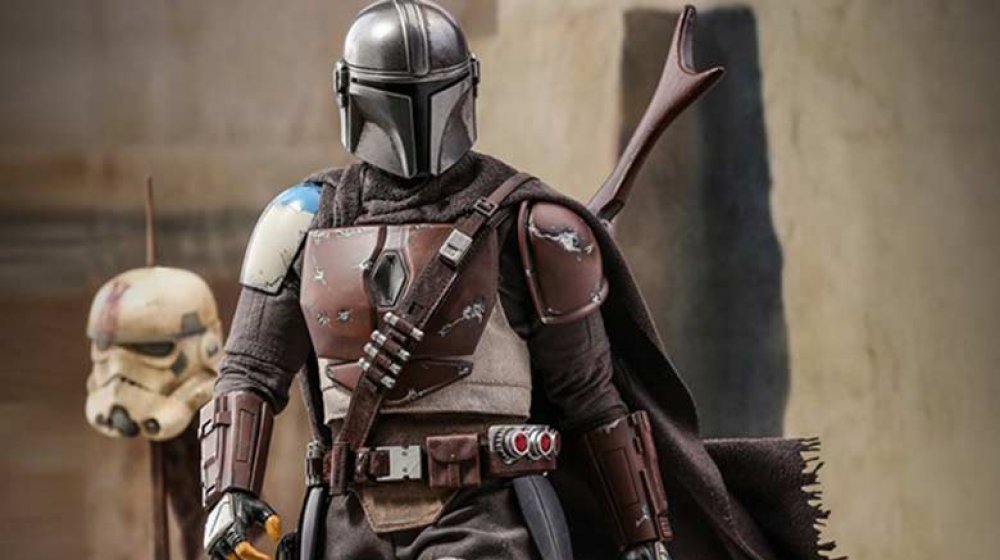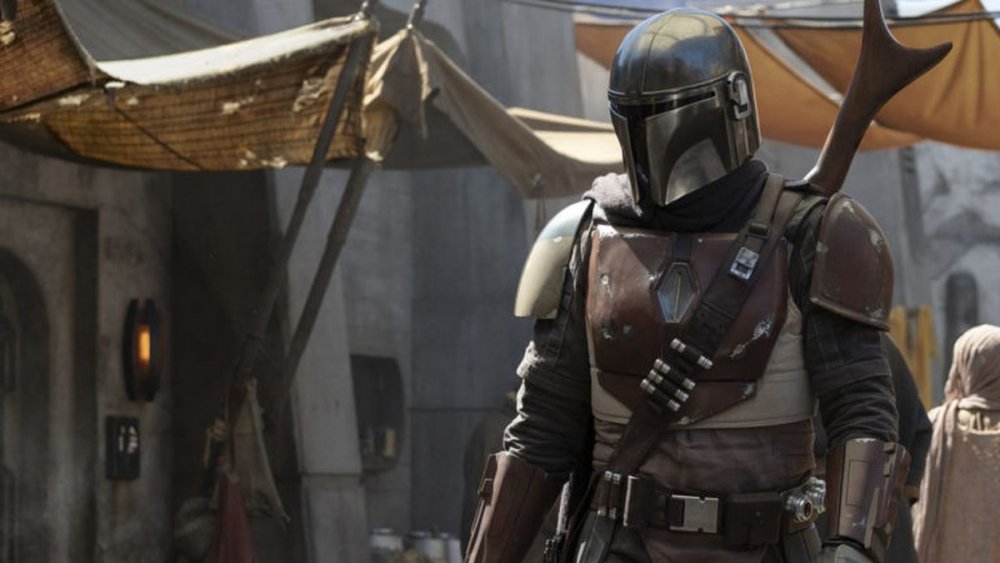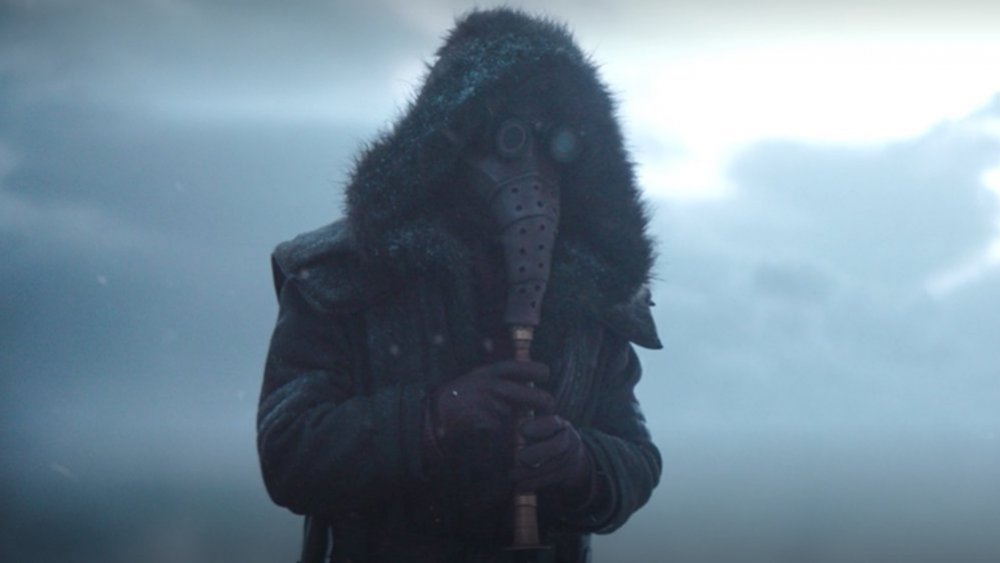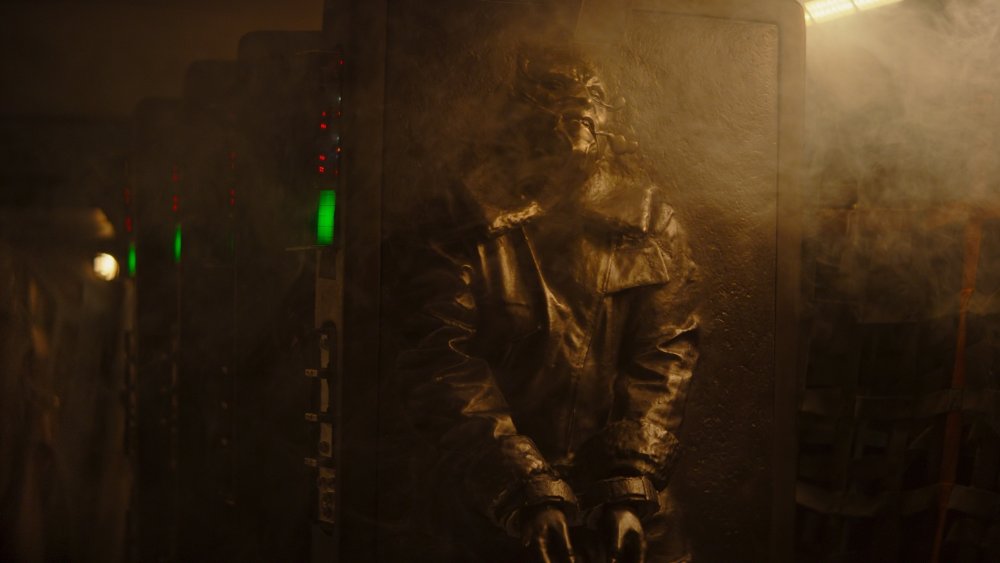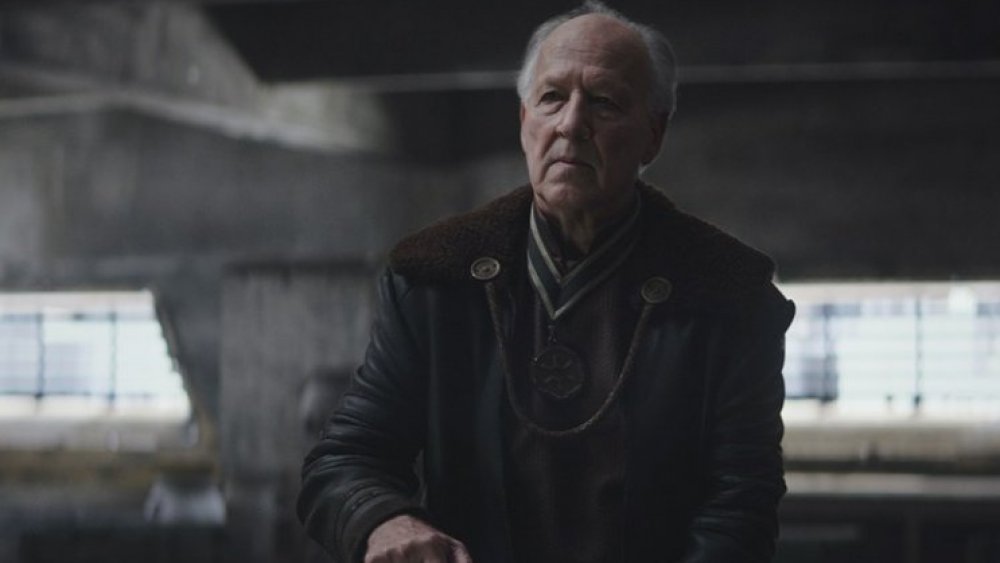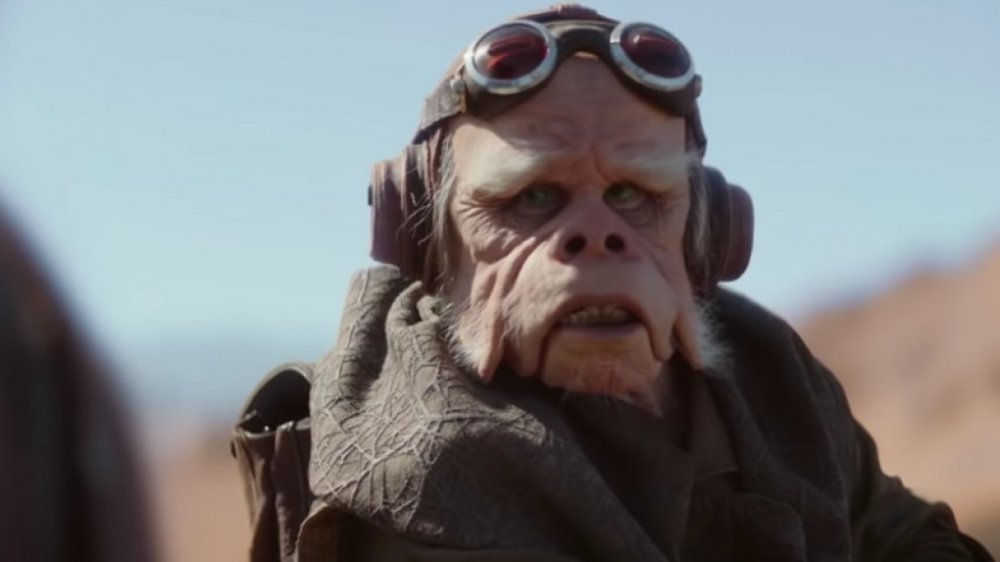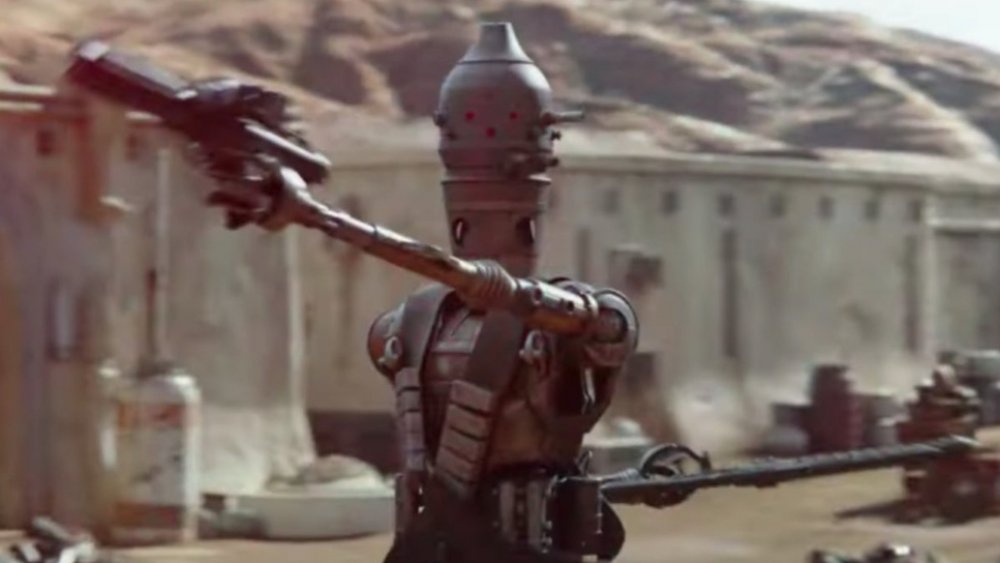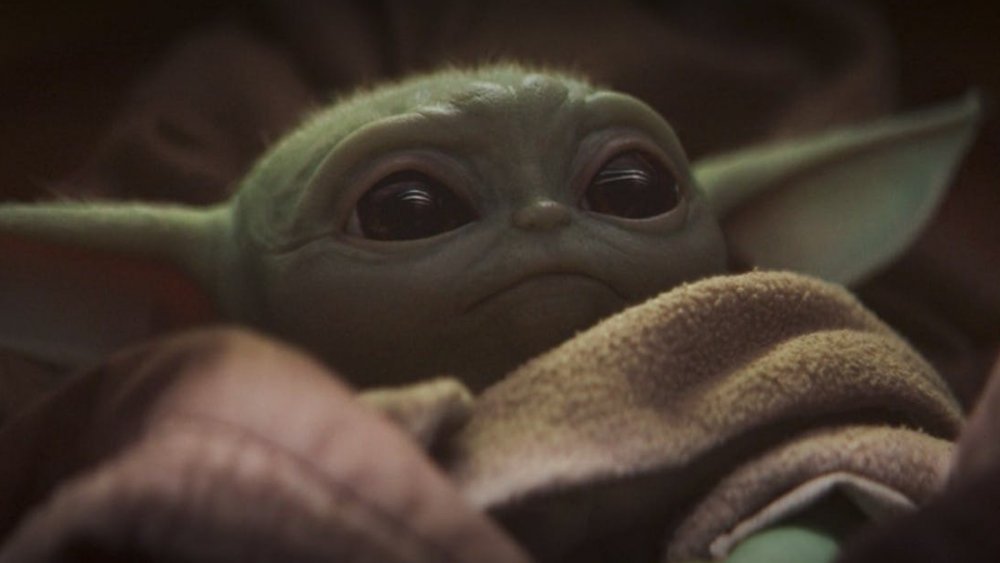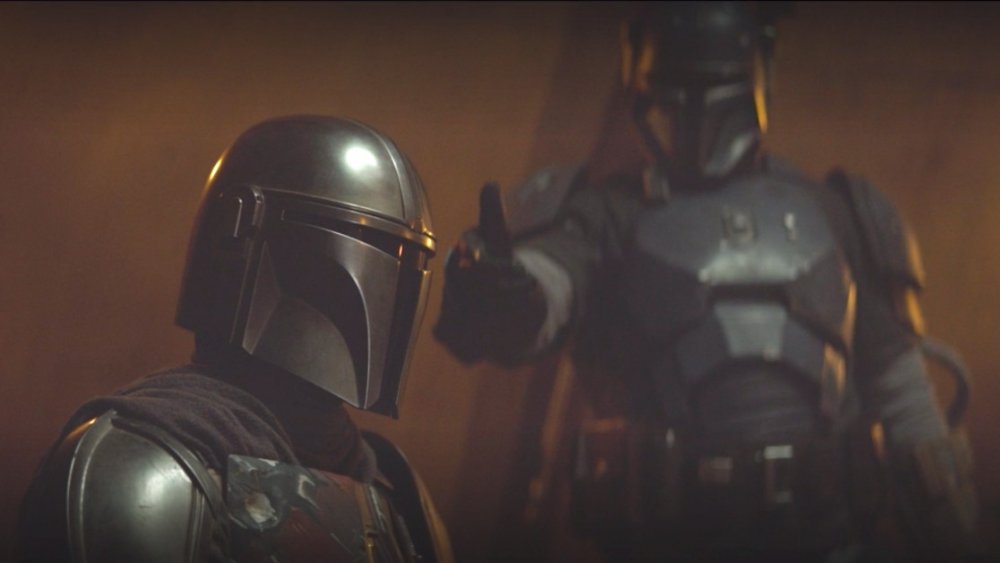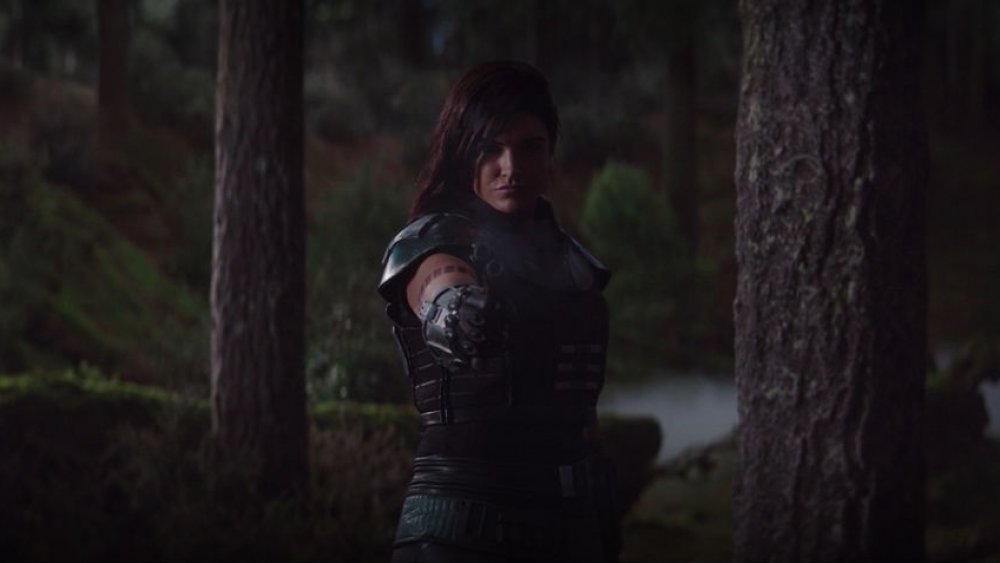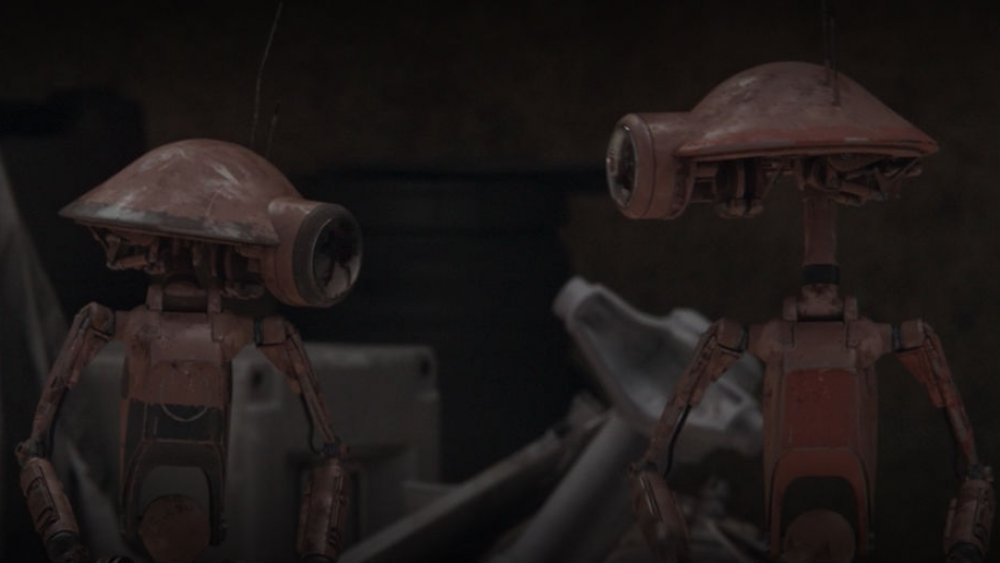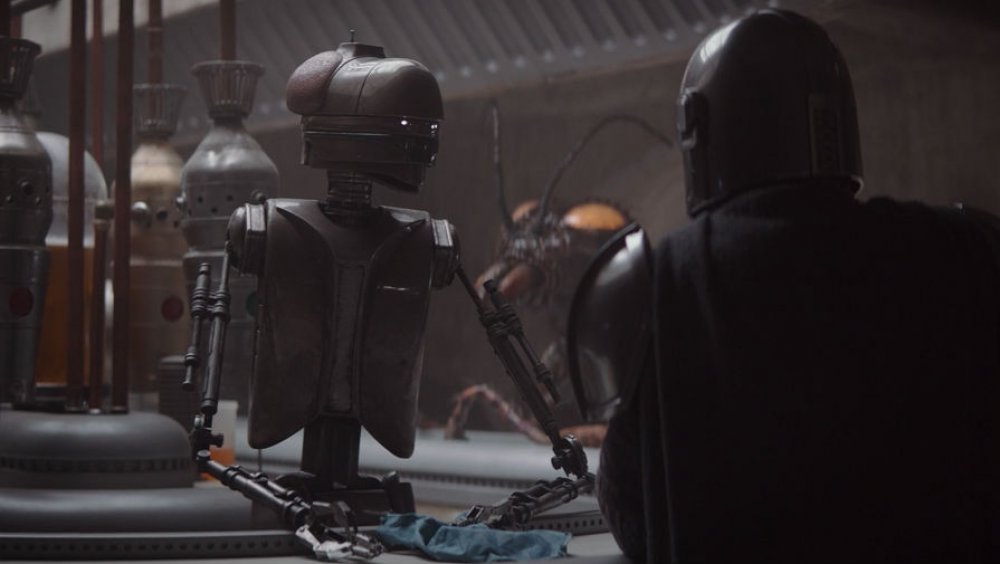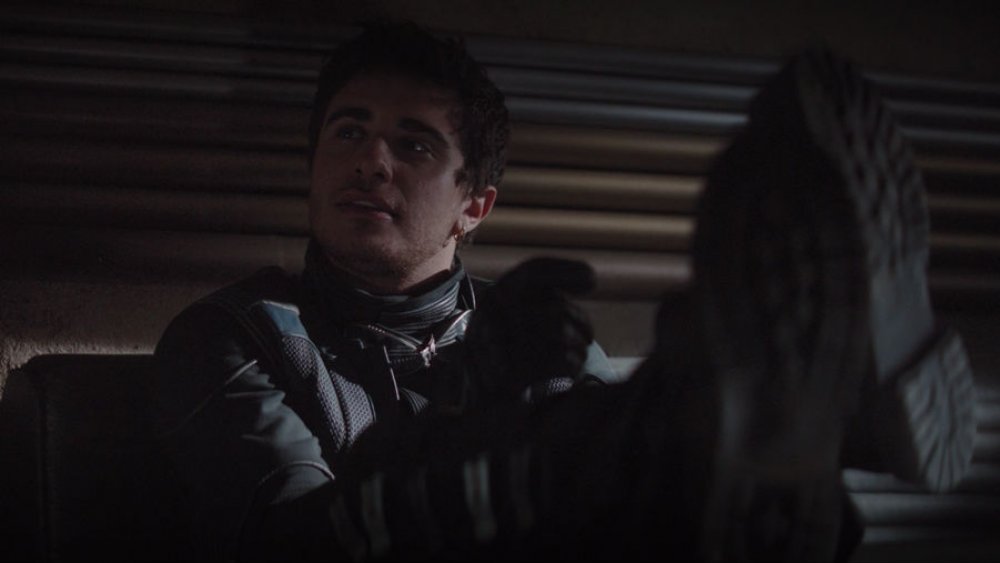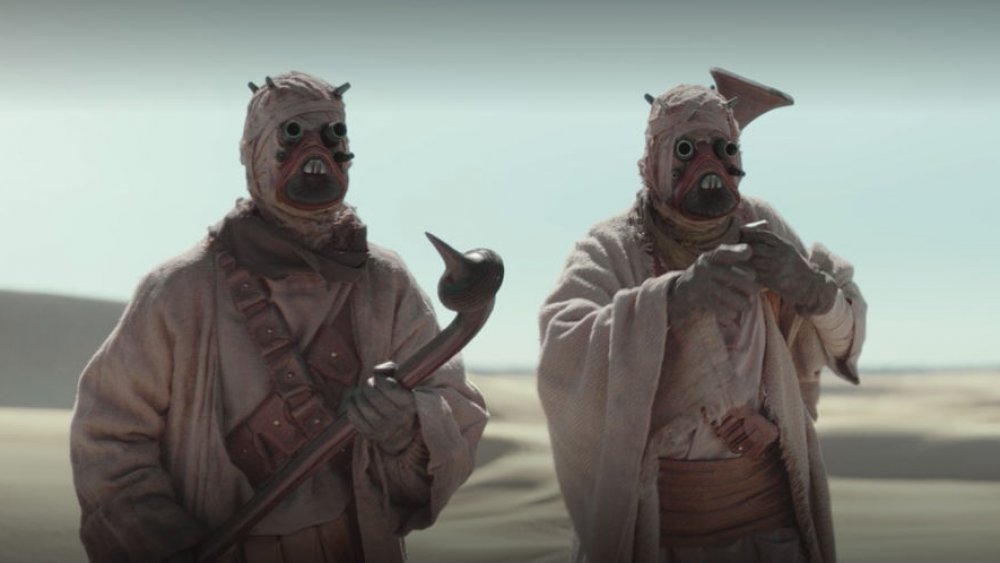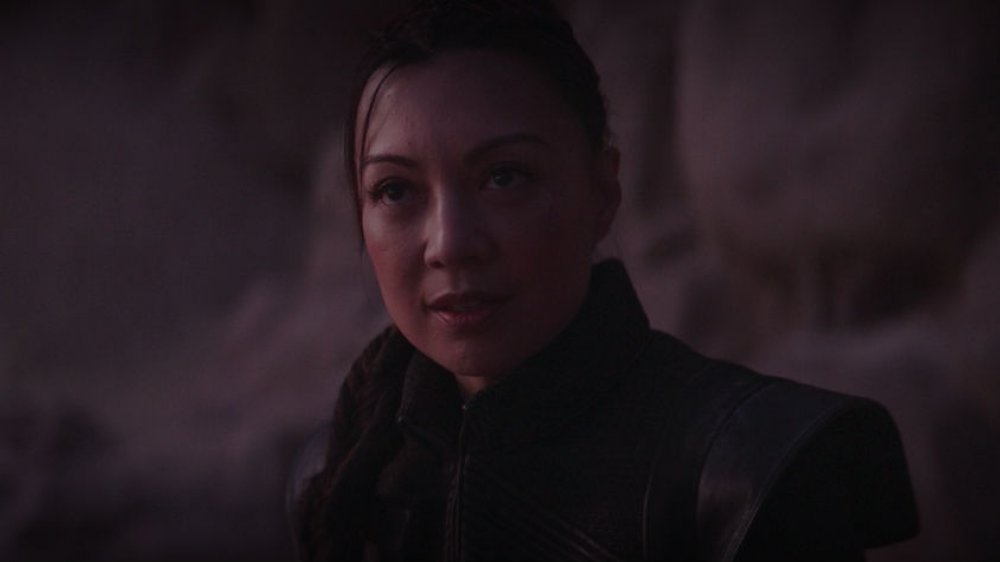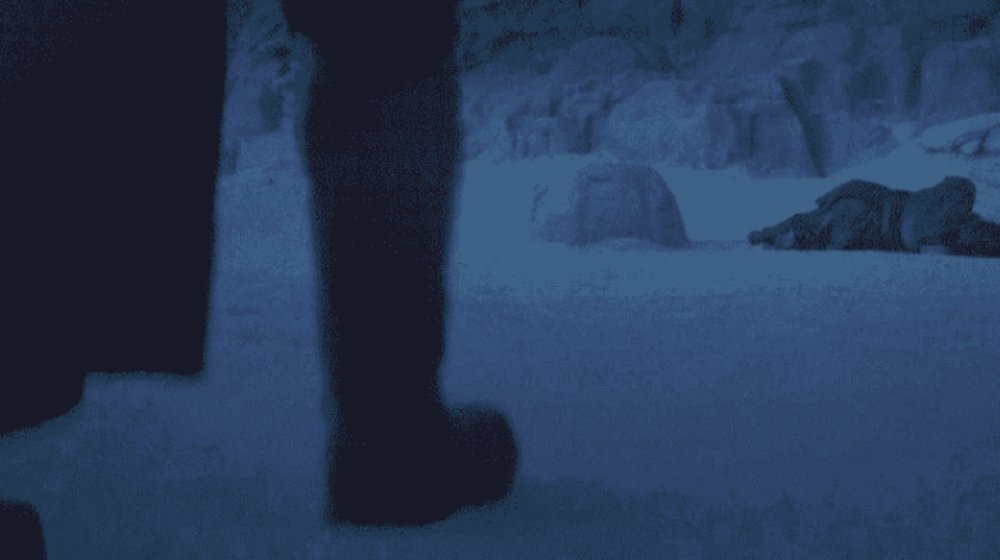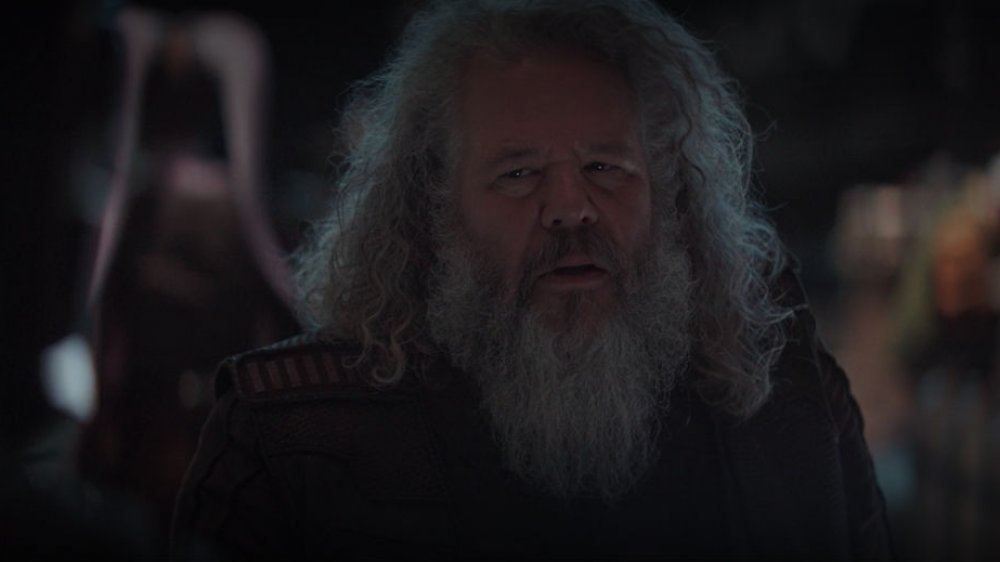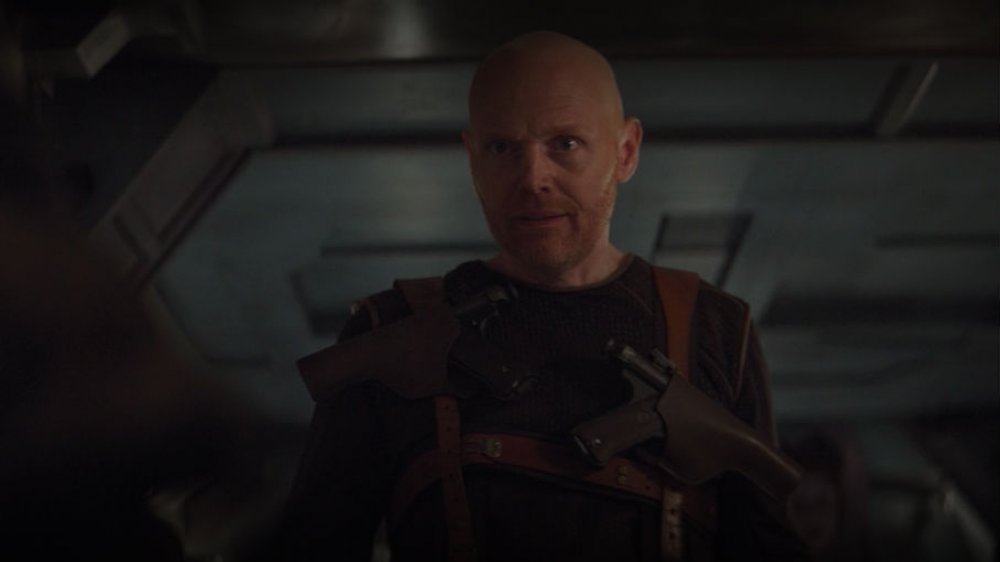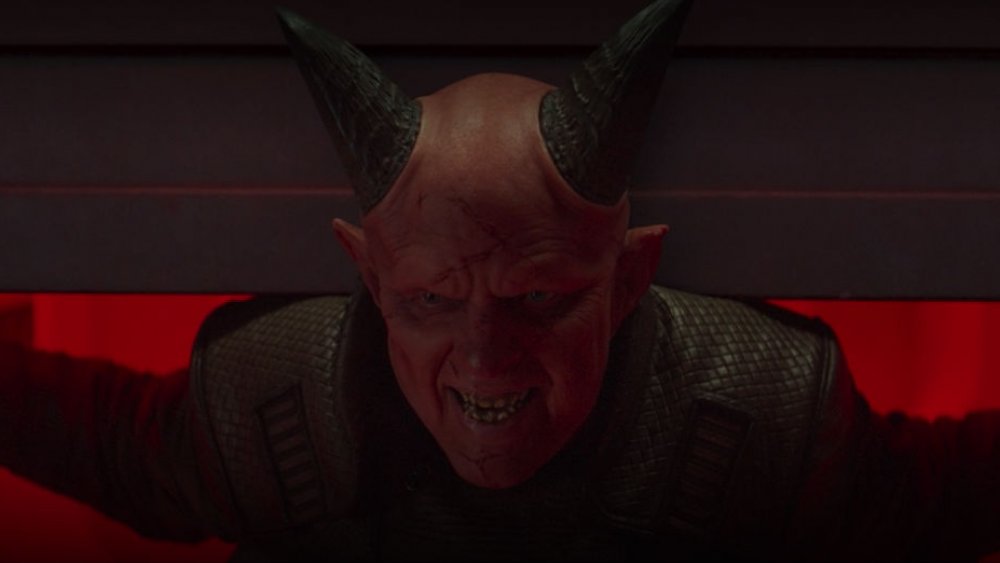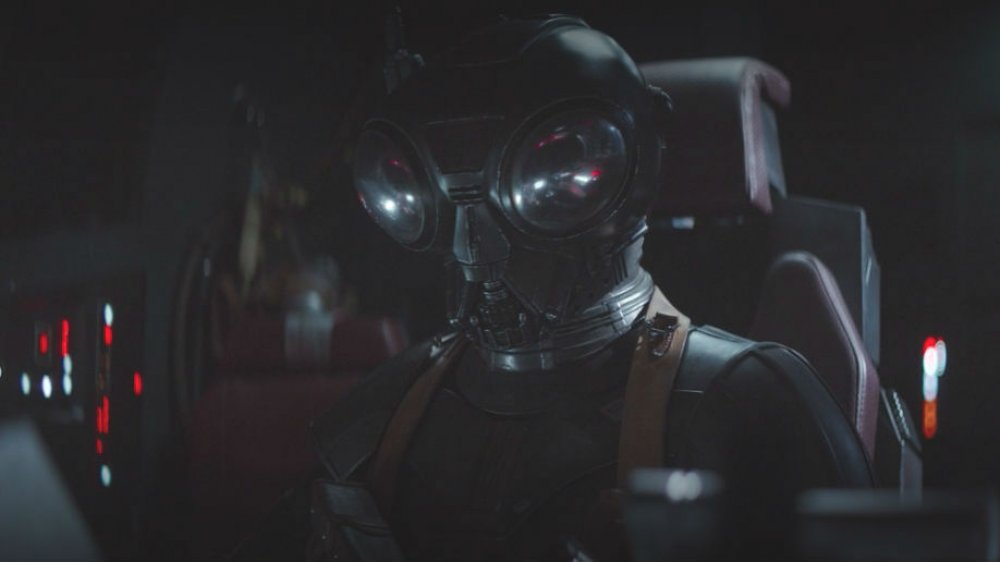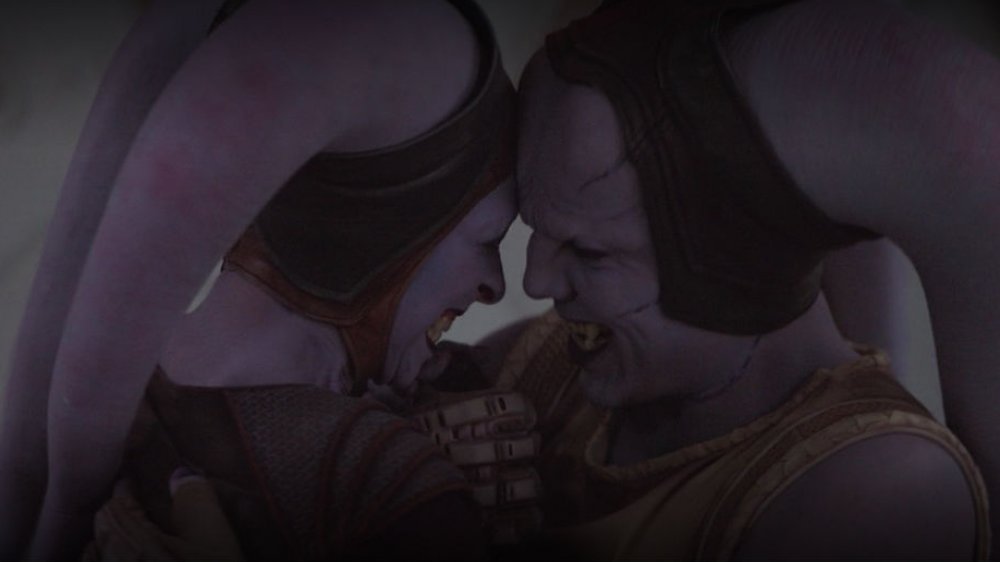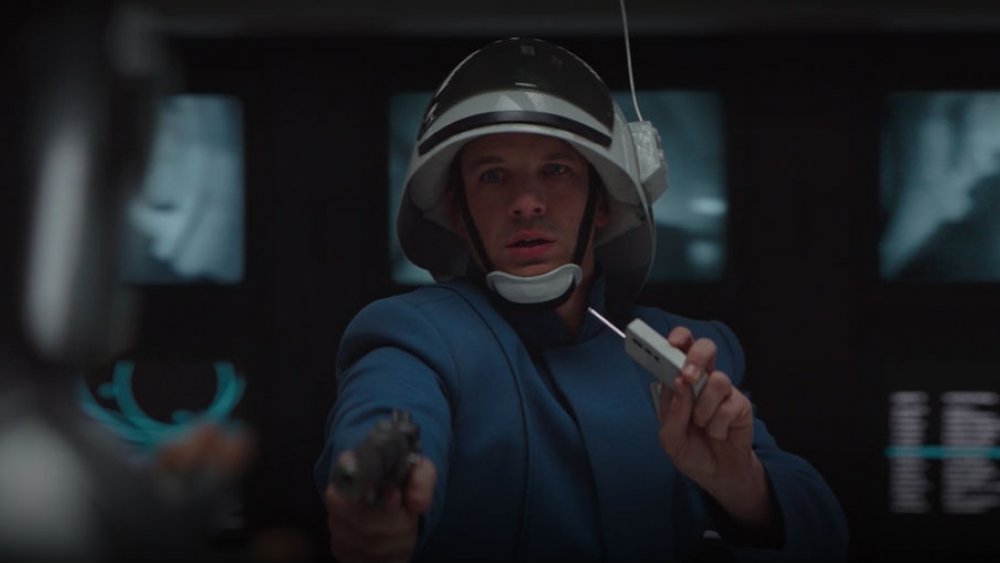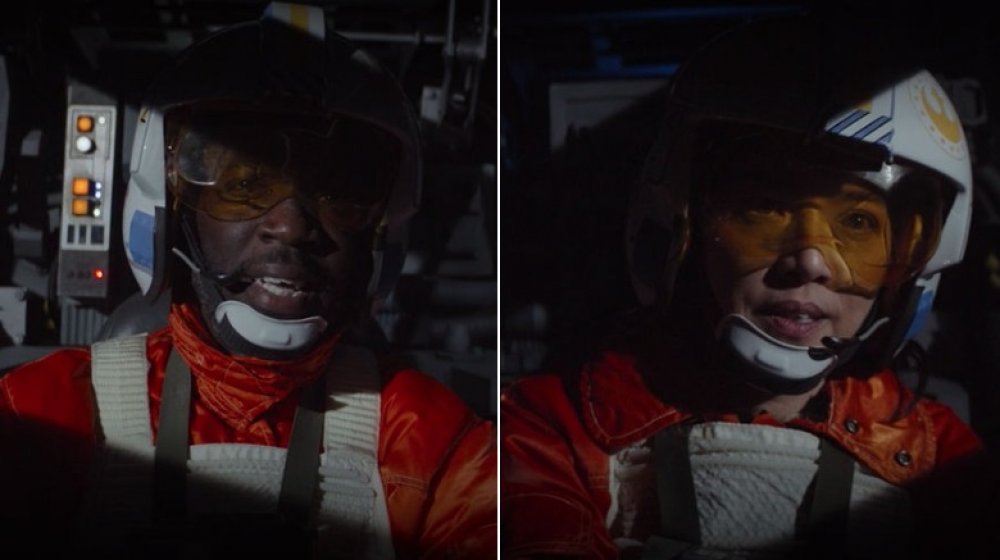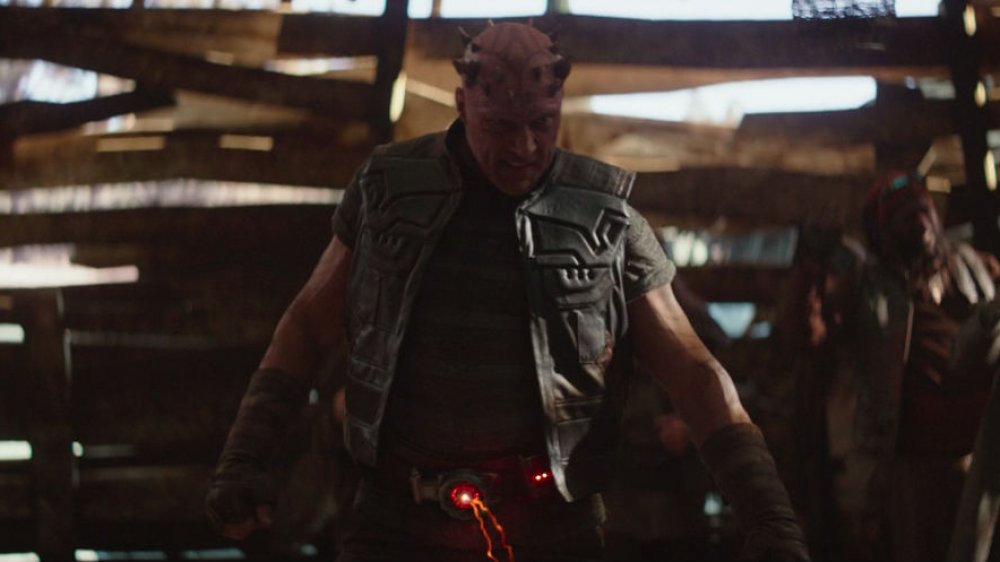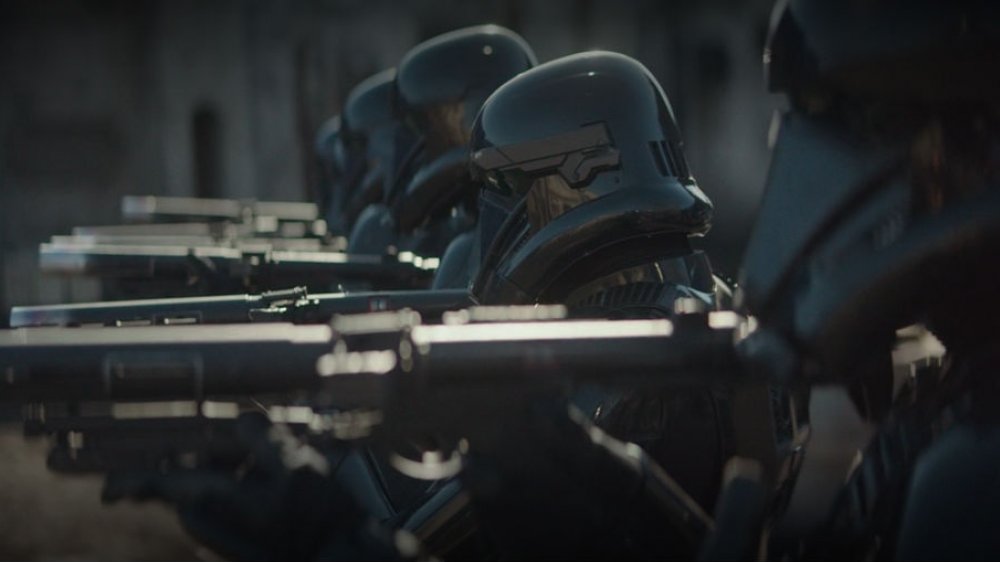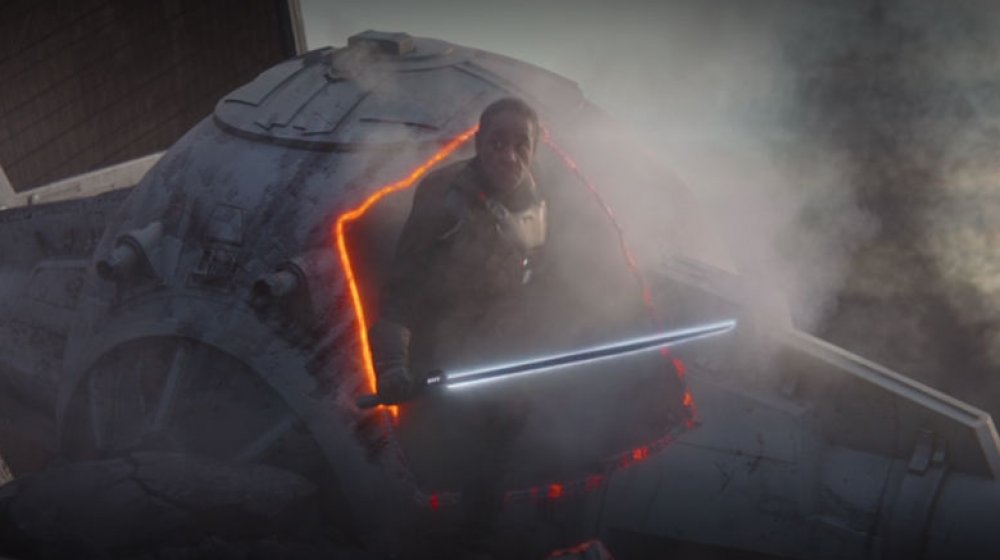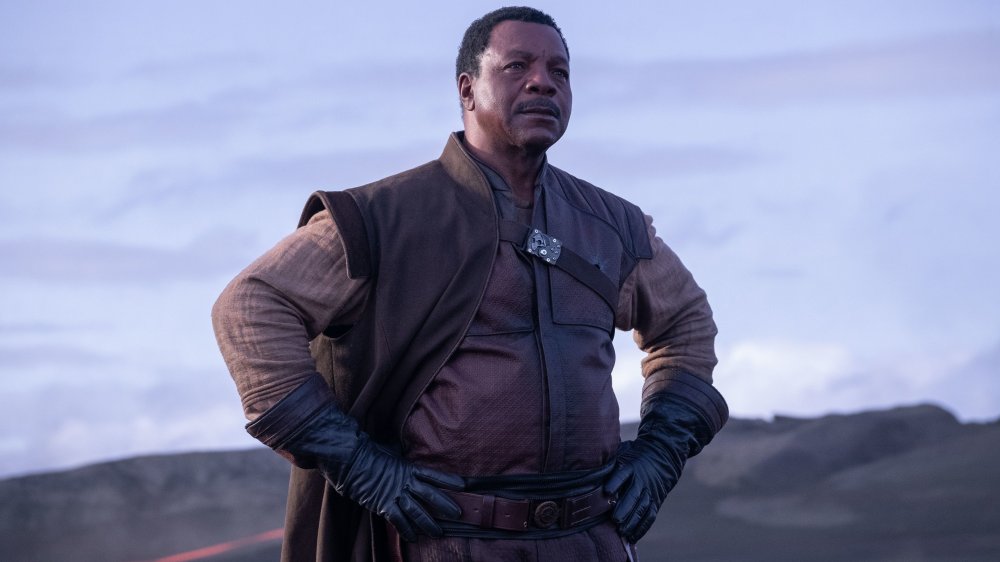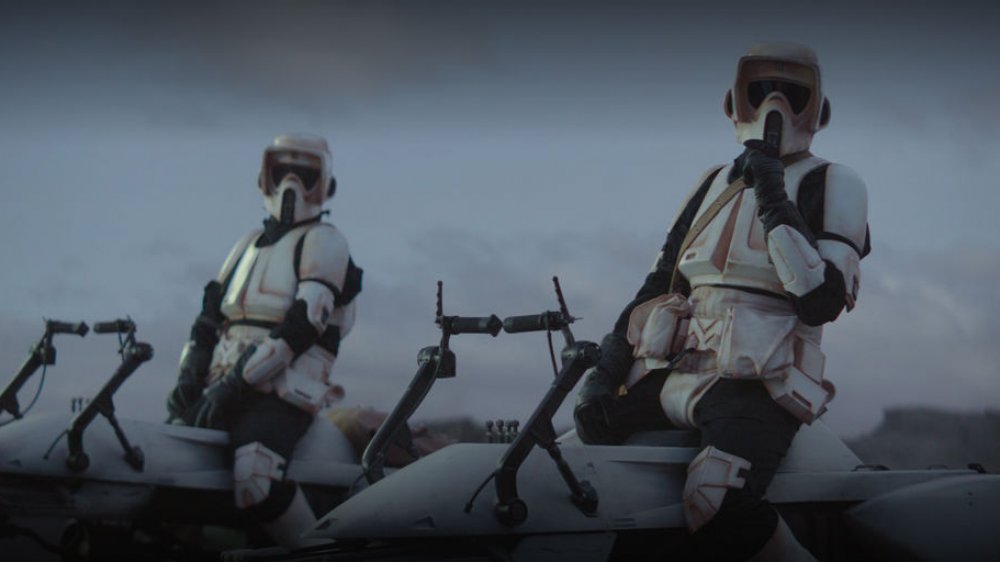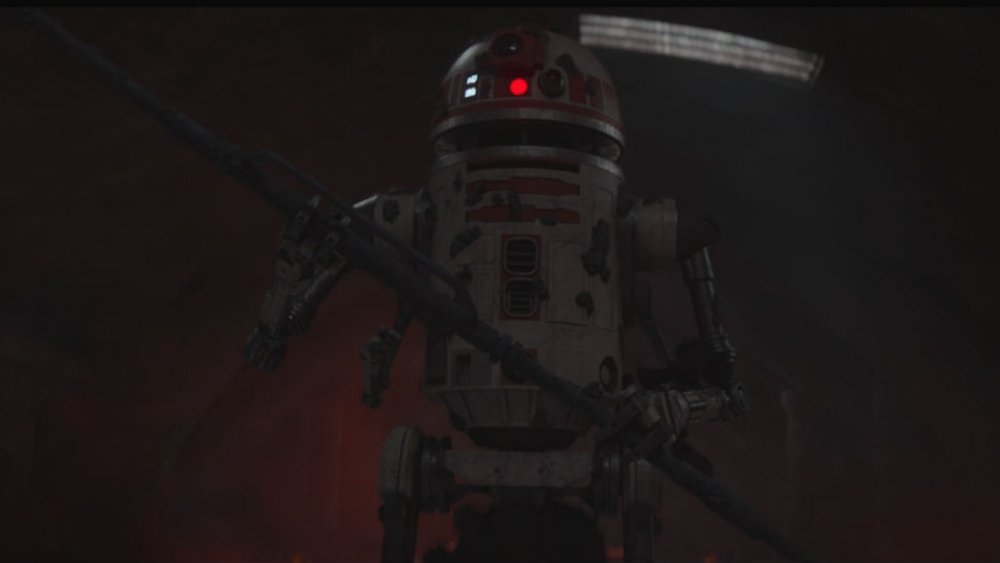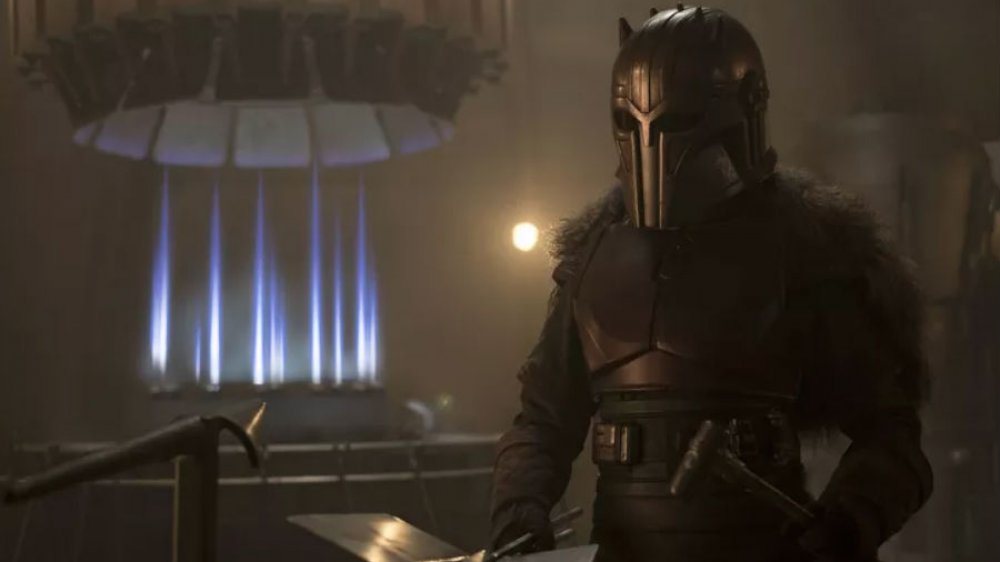Characters In The Mandalorian With More Meaning Than You Realize
Disney+ is finally here, and with it comes its first live-action original Star Wars series, The Mandalorian. Set a few years after Return of the Jedi, the show feels like equal parts bleak western action adventure and samurai epic, all with the vast Star Wars universe as its backdrop.
And the show's creators have done their homework. It takes more than a cursory knowledge of the Star Wars narrative to create what we've seen so far on The Mandalorian. Along with a bountiful basket of Easter eggs we meet characters — both minor players and those with a bit more narrative weight — who let us know just how deeply the show's creative team is willing to dive into the lore. From the show's very first scene, hardcore Star Wars fans can tell that when The Mandalorian creator Jon Favreau went to George Lucas for guidance, it wasn't just a PR move — he took Lucas' words seriously.
Some of these characters are simply callbacks to early Star Wars movies, some answer questions to decades-old questions, and others just bring up more questions — maybe even more questions than The Mandalorian will have time to answer. But they're all characters in The Mandalorian with more meaning than you realize.
The Mandalorian reminds us of the past and leaves us with lots of questions
When we first meet him, the Mandalorian (Pedro Pascal), or "Mando" as head of the Bounty Hunters' Guild Greef Karga (Carl Weathers) calls him, is a walking collection of mysteries and callbacks to older Star Wars lore. There's his rifle, which we see him using early against the beast that tries to drag his ship underwater in Chapter 1 and later to disintegrate Jawas and rival bounty hunters. It's the same weapon Boba Fett is armed with during his animated introduction in the Star Wars Holiday Special, though we never see Fett armed with it in the films.
By the end of the first season, we've learned more details about this enigmatic warrior. While Mando and his allies are cornered by Moff Gideon and his Imperial forces, Gideon reveals he knows quite a bit about our heroes, including Mando's real name — Din Djarin. Once Gideon delivers his ultimatum and the heroes discuss what to do, we finally get the full flashback scene that we've only seen bits and pieces of throughout the season. Din, we learn, was not born on Mandalore. He was a foundling — a child saved from Separatist super battle droids by Mandalorian warriors. He was raised in their Fighting Corp and later sworn to the Creed, essentially becoming a Mandalorian himself.
We also finally get the chance to see Mando's face in the season finale. After being wounded by Moff Gideon, Mando insists on staying behind as his allies escape to the sewers with the Child. IG-11, reprogrammed as a nurse droid, convinces Mando to remove his helmet so the droid can save him. Mando resists at first, until IG-11 reminds him he is not a "living thing," and so showing the droid his face will not go against his vows.
The Kubaz flutist reminds us of A New Hope and an old story
Plot-wise, the masked, long-snouted character who calls the Mandalorian his ride early in Chapter 1 doesn't do all that much. He calls Mando a droid-driven speeder, Mando passes on the droid, and the alien calls him a speeder that's literally falling apart and driven by famous funny nerd Brian Posehn. But the goggled flutist has more meaning not only as far as Star Wars lore is concerned, but the ancient narrative roots The Mandalorian is tapping into.
More involved Star Wars fans will recognize the flutist as an alien called a Kubaz — it's a Kubaz in A New Hope who stalks the heroes around Mos Eisley and turns them in to the Imperial Storm Troopers. But he's more than just an Easter egg. When discussing the advice George Lucas gave him, Mandalorian creator Jon Favreau revealed that Lucas reminded him to think about ancient stories of heroism. Lucas was heavily influenced by the writing of Joseph Campbell, whose book The Hero with a Thousand Faces breaks down the commonalities among heroic tales in different cultures. In light of this, the flutist Kubaz seems like a clear reflection of Lucas' advice, as the scene is reminiscent of the myth of the River Styx. In ancient Greek myth, Styx was a river crossed by the newly dead by way of the ferryman Charon, but the passage cost a coin — like the one Mando tosses to the Kubaz.
A Kubaz sniper later appears in Chapter 4, attempting to assassinate Baby Yoda. We don't know for sure whether or not this was the same character we met in the first episode, but it's certainly interesting to see The Mandalorian building upon what had once been a blink-and-you'll-miss-it masked alien.
The Mandalorian's frozen bounties tell us something about the progress of Star Wars tech
Early in Chapter 1, the Mandalorian's finned mark stumbles upon his other marks, all lined up and frozen in carbonite. Seconds later, the blue alien joins them. The row of frozen prisoners tells us a lot about how technology has advanced since the fall of the Empire, at least when it comes to the carbon freezing process. Fans, of course, will recall that in one of the most emotionally harrowing moments of the original trilogy, the Empire tests Cloud City's freezing chamber on Han Solo in hopes of later using it to kidnap Luke Skywalker. Once Solo's frozen, Boba Fett takes him to Jabba the Hutt. In The Empire Strikes Back, though, we're made to believe this isn't exactly a common practice. Lando tells Darth Vader they've never frozen a person before and don't know if they'll survive, which is exactly why they test it on Solo.
Yet by The Mandalorian the technique is so commonplace that Mando is able to quickly freeze his bounty without endangering himself, and without the enormous chamber seen in Cloud City. It makes sense if you think about it — Jabba proudly displays Han Solo's frozen body in his palace, and news of the display probably travels fast in the underworld of Star Wars. It probably doesn't take long for an enterprising bounty hunter to look into technology that could make carbon-freezing more mobile.
The Client speaks volumes about the resiliency of The Empire
There are a couple of interesting things going on with as "The Client," the cold Imperial who hires the Mandalorian to bring him "the asset," and who reacts with such a brimming undertone of threat when Mando dares to ask him what will happen to the asset once he has it.
For starters, there's the surprising but perfect casting choice of Werner Herzog. While Herzog has acted before, he's best known as an acclaimed director of existential art films. He's made documentaries like 2005's Grizzly Man, 2010's Cave of Forgotten Dreams, and the 2018 biographical documentary about the Soviet Union's final head of state, Meeting Gorbachev. He's also known for more fictional fare like 2009's Bad Lieutenant: Port of Call New Orleans and the 1972 cult classic Aguirre, the Wrath of God.
Even setting aside the casting choice, the Client tells us a lot about the post-Imperial Star Wars world while at the same time leading to some interesting questions. The Client is presumably someone who wielded a good deal of power in the Empire before its fall. In spite of the Empire's defeat in Return of the Jedi, the Client has significant resources and influence — at least enough to operate without too much concern. He's managed to keep a loyal band of stormtroopers by his side, as well as some kind of intelligence network. Clearly, the Empire is not as dead as the Death Star.
The Mandalorian's farmer ally is a callback to The Empire Strikes Back
If Kuiil — the alien farmer in The Mandalorian's first two chapters who helps Mando find the asset and to get back home — looks familiar to you, there are a few reasons why that might be the case. Sure, it could be because you recognize the facial similarities to Nick Nolte, who voices the elderly farmer. It could be because somehow the faint Nolte facial features plus the alien face makes him look not all that different from Ron Perlman. But it might also be that you remember one of the diminutive races we meet in 1980's The Empire Strikes Back.
Kuiil is an Ugnaught, a race seen in Bespin's floating Cloud City. They're the guys working the machines when Han Solo is frozen in carbonite, and they're the ones playing catch with C-3PO's golden head when Chewebacca saves it and the rest of the droid from being scrapped.
In Chapter 7 we learn Kuliil was forced to work for the Empire as an indentured servant, though he ultimately worked off his people's debt. We also learn that the farmer is much more technically skilled than we realized, as he's able to revive and reprogram the assassin droid IG-11.
IG-11 shows us how a droid can be a killer... and a hero
If nothing else, the explosive shoot-out ending of Chapter 1 answers a question some fans have probably been asking ever since 1980's Empire Strikes Back: exactly how would a droid perform as a bounty hunter? While he's not the same droid, physically IG-11 is very similar to IG-88, the droid who appears briefly in Episode V. While we don't get to see much of them beyond Boba Fett, the small group of bounty hunters Darth Vader sets on the heroes' trail made a strong enough impression on fans to keep their curiosities piqued over the years. The way IG-11 easily brushes aside the asset's guards (at least, at first), and how his droid body allows him to attack in multiple directions simultaneously while reacting to numerous assaults goes a long way to explain exactly what IG-88 was doing on Vader's ship all those years ago.
Anyone worried we wouldn't get any more of Taika Waititi's voice work as IG-11 has a pleasant surprise waiting for them in Chapter 7. Early in the episode, we learn the Ugnaught farmer Kuiil went to the compound where Baby Yoda was being held after the firefight and retrieved IG-11. He revives the bounty hunter droid and trains him to perform more mundane tasks like feeding cattle and serving tea.
After Kuiil is killed by storm troopers at the end of Chapter 7 and the Child is captured, IG-11 proves just how well Kuiil's reprogramming stuck. The droid avenges his fallen master by killing the troopers who murdered Kuiil, and retrieves the Child. He races into the town, tears through the Imperial forces, and reconnects with Mando and his allies. His arrival gives the heroes a fighting chance, and later in the episode the droid sacrifices himself to allow the Child and his protectors to escape the underground lava river.
Baby Yoda leads to more questions about a mysterious species
Baby Yoda. Can you believe it? It's too frickin' cute.
Chapter 1 of The Mandalorian ends with the huge reveal that the asset — Mando's target and apparently the target of every single member of the Bounty Hunter's Guild — is an infant member of whatever species the late Jedi Master Yoda hails from. We're not being lazy here. No one knows much about Yoda's species and George Lucas kept it unnamed on purpose. But the baby's presence and Mando's affection for it has some huge implications for the Star Wars mythos.
For one thing, the way the infant saves Mando from the horned beast in Chapter 2 tells us Yoda's species is even more attuned with the Force than we ever imagined. Its age leads us to a lot of questions — at 50 years old, Baby Yoda would have been alive during the era of the prequel films. Could it be that it was hidden just before the Empire came to power? Did Yoda know about the baby?
Not to mention, who was guarding Baby Yoda in the first place? Who was paying for all the men that the Mandalorian and IG-11 had to kill to get to it? And, more importantly, why were they guarding it?
The hidden Mandalorians
In Chapter 3, we get a lot more Mandalorian than we bargained for. After turning Baby Yoda over to the Client, Mando earns a treasure trove of Beskar steel, which he brings to the mysterious Armorer seen in the first episode. This draws the attention of the other helmeted Mandalorians in what appears to be a hidden underground compound, and one of them isn't too happy with Mando acquiring the Beskar by working for remnants of the Empire. The Armorer helps to cool tempers, but this — along with the episode's final scene in which the Mandalorians emerge from hiding to help Mando and Baby Yoda escape — tells us a lot about this defeated people while still raising more questions.
We learn from the brief melee between Mando and his brethren in Chapter 3 that the Mandalorians follow a strict warrior code. We hear them repeat the phrase "This is the way" a number of times, and when the Armorer suggests Mando's defeat of the Mudhorn means he's earned the beast as his signet, Mando refuses because it wasn't "a noble kill." The very fact that the other Mandalorians compromise their hideout to fight for Mando and his charge in spite of their earlier hostility towards him speaks volumes to a complex but unyielding sense of honor.
In the first season finale, we learn most of the Mandalorian hunters who come to Mando and the Child's rescue in Chapter 3 were later hunted down and killed by Imperial forces. When Mando and his allies travel into the underground covert, they find a pile of broken and bloodied Mandalorian armor. The mysterious Armorer soon appears and tells the heroes what happened, though she and Mando express hope that at least a few hunters escaped off-planet.
Cara Dune is a veteran of the Rebellion and a survivor of Alderaan
In Chapter 4 we meet Cara Dune, a former shock trooper for the Rebellion. Mando takes note of Cara as soon as he arrives on Sorgan, worrying she's there to kill him and take Baby Yoda to whatever horrific fate the last remnants of the Empire have in store for him. Cara notices Mando too, makes similar assumptions about him, and the two mercenaries enjoy a fairly brutal melee before making peace.
After their fight, Cara tells Mando she became a mercenary after the fall of the Empire. She describes being relegated to duties she couldn't stomach like "protecting delegates, suppressing riots" once her role of shock trooper was over, at which point she became a gun for hire. In Chapter 7 we learn that no matter how long ago the war ended, Cara still has nothing but hatred for the Empire. When Mando tries to recruit Cara to help him with the Client, at first Cara seems like there's no way she'll go anywhere with him. Once she finds out the target is an Imperial, she says simply, "I'm in."
In the season 1 finale, we learn two new things about Cara, and one in particular suggests exactly why she harbors such vengeful feelings towards the Empire. When the heroes are cornered by Moff Gideon and his forces, Gideon reveals he knows very specific information about all of them, including Cara. He refers to her as "Carasynthia of Alderaan," which tells us not only Cara's full first name but that she shares a homeworld with Princess Leia. Alderaan is the planet destroyed by the Death Star in A New Hope. Knowing this, it seems more than likely the annihilation of her home and probably most of her friends and family is exactly why Cara drops everything for the chance to kill Imperials.
Chapter 5 brings back some comic relief droids from The Phantom Menace
Chapter 5 of The Mandalorian opens with our heroes in space, getting chased by another money-hungry bounty hunter. Mando eventually destroys his pursuer's ship, but not before his own ride, the Razorcrest, takes damage. He's forced to land at the nearest planet — the Star Wars mainstay, Tatooine.
The Razorcrest's landing awakens a small squad of slapstick droids whose design you may remember from The Phantom Menace, in which we see our first pit droid in Watto's shop. While dormant, the droids almost look like metal turtles. When Jar Jar Binks unintentionally brings one to life, the young Anakin lets him know that pressing their prominent noses is what puts them back in their dormant stage. We see more of the comical pit droids in the podrace sequence, during which they act as clumsy, Three-Stooges-esque mechanics for the racers.
Mando insists the human mechanic Peli not allow any of her pit droids near the Razorcrest, and he's got a couple good reasons why. There are the obvious ones — he doesn't want any of them finding Baby Yoda, and he's shown a particular distaste for droids since Chapter 1 (super battle droids did seemingly kill his family, after all). But Mando's also probably aware of how remarkably bad the droids tend to be at their jobs. In Episode I's pod race, we see the droids do far more harm than good when their antics get one of the droids sucked into the pod engine of Ody Mandrell, scrapping the diminutive alien's chances at a win.
A familiar-looking droid says a lot about post-Empire Tatooine
When Mando talks to a droid bartender in the Mos Eisley cantina, the exchange tells us a lot more about the post-Empire Tatooine than you may realize. If the droid looks familiar, then you probably remember one of the same series — EV-9D9 — who was something of a droid supervisor in Jabba's Place. We don't see her much, but she's the one who checks in C-3PO and R2-D2 after Luke Skywalker gives them to Jabba as gifts.
More important than the Return of the Jedi reference is the throwback to A New Hope. The cantina Mando finds look exactly like the one where Luke and Obi-Wan find Han and Chewie. But remember what happens when Luke tries to bring the droids in with him in Episode IV? The bartender loudly tells him that "their kind" aren't allowed in there. Not only are they allowed in now but, considering we see a second droid behind the bar with the EV Mando talks to, they seem to be running the place. In light of this and other hints we get about the changes on Tatooine, is it possible the New Republic has brought some level of droid rights to the outer rim?
Toro Calican shows us how desperate Mando is
The eager, green bounty hunter Toro Calican eventually proves to be as much of a snake as his chosen profession would require him to be. At first seeming like he simply wants a hand in getting in the door of the Bounty Hunter's Guild, Toro eventually turns on Mando and dies for his troubles. It says a lot about exactly where Mando's state of mind is as of Chapter 5 is that he agrees to partner with the headstrong young bounty hunter.
We still don't know a lot about Mando, but we do know he doesn't exactly overflow with trust toward strangers. It's almost unthinkable that he would give Toro the chance to pull the wool over his eyes. Once he knows the young bounty hunter wants to join the Guild — the same guild that is ruthlessly hunting him and Baby Yoda — the fact that he would agree to work with Toro and at one point even allow him to see Baby Yoda is kind of insane. Mando is clearly much more desperate than he wants to appear, otherwise he would've left Toro high and dry in the cantina.
You can hardly blame him. He's being hunted by more bounty hunters than Han Solo in his prime, and with no guild membership he has no dependable way to make money. Things are probably going to get tougher for Mando before they get any better.
Chapter 5 shows us a different side of the Tusken Raiders
With Mando on Tatooine in Chapter 5, we get a chance to see a lot of old "friends," and that includes the masked Tusken Raiders. You might remember that the Tuskens play pretty significant roles in both the original trilogy and the prequels. In A New Hope Obi-Wan Kenobi scares them off when they try to rob Luke Skywalker, in The Phantom Menace they shoot at pod racers for fun, and in Attack of the Clones a Tusken war party makes the mistake of capturing Anakin's mother Shmi. When she dies in captivity, Anakin slaughters all the Tusken men, women, and children in sight — a significant moment in his turn to the dark side.
In Chapter 5 of The Mandalorian we see something very rare — a civil exchange with Tusken Raiders. When a pair of them show up near Mando and Toro (with more waiting nearby) Mando reveals that he knows the Tuskens' sign language, and he negotiates passage through the desert. In exchange for Toro's electrobinoculars, the pair are allowed to go about their business. We've never seen our hero characters even try to actually communicate with Tuskens, and it's interesting to learn that they aren't necessarily the "savages" Obi-Wan once painted them as, providing you treat them with a certain level of respect.
This civil exchange could be the result of how the New Republic has made Tatooine a somewhat kinder, gentler place. Of course, it's also possible that the Tuskens recognize Mando for what he is and would rather bargain than fight. It's even possible, considering he knows their sign language, that Mando has dealt with this group of Tuskens before. The chance seems remote, but he had to learn the language somewhere, right?
The plight of Fennec Shand tells us about the state of the Hutts
Ming-Na Wen appears in Chapter 5 as the vicious Fennec Shand, an assassin who we're told has been on the run ever since the New Republic imprisoned many of her old employers. We don't know exactly who those employers are, but Mando guesses they could've included the Hutts. That seems likely, considering she's in hiding on Tatooine, which we know from previous Star Wars tales has historically been under Hutt control.
The very fact that Shand is on the run, along with what little background we get from Toro and Mando, suggests that the Hutts may no longer be in charge. That's kind of surprising, even with the fall of the Empire. Sure, Jabba the Hutt died during the events of Return of the Jedi, but he was hardly the only Hutt. You would expect another would come in to fill the power vacuum left by the crime lord's death. The Hutts operated on Tatooine free from interference during the reign of the old Republic, so why would that change with the new one? Perhaps with Luke Skywalker's ties to Tatooine and his part in defeating the Empire, the New Republic gave the desert planet more attention than other Outer Rim worlds.
Could the shadowy figure at the end of Chapter 5 be another memorable bounty hunter?
After Mando and Baby Yoda finally blast away from Tatooine, we meet someone else — or at least, we meet their feet. We don't see much of the dark, shadowy figure who approaches Fennec Shand's corpse and we don't know much about them. But it's a good guess they're stalking Mando and his young charge, and considering the prominent cape and the setting, we can't help but wonder if it could be someone fans have been hoping would show up in the series — the bounty hunter from the original trilogy, Boba Fett.
Boba Fett supposedly died in Return of the Jedi when he was knocked into the Sarlacc Pit. But in some versions of the expanded universe (parts that are no longer considered canon), Boba Fett's armor helps him survive and eventually escape. Lots of fans have been hoping the legendary bounty hunter would eventually show up in The Mandalorian, and it's possible this is who we see examining Shand's corpse at the end of Chapter 5.
It's not definitive by any means. After all, it isn't as if Mando and Boba Fett are the only Star Wars characters with capes. Hell, in Solo we find out Lando Calrissian keeps whole closets of the things. The shadowy figure could be employed by Giancarlo Esposito's mysterious Moff Gideon. Really, it could be anyone, and even the first season finale doesn't offer an answer. But considering the character's identity is kept secret and the planet we find them on, if nothing else the show's creative team seems to want us to think that it could be Fett.
Ran has a spotty history with Mando
Chapter 6, "The Prisoner," begins with Mando accepting a job from a seedy character named Ranzar "Ran" Malk. Like a lot of the dialogue in the episode between Mando and his colleagues, there are vague mentions of some kind of past conflict between Ran and the Mandalorian. Ran never specifies what happened, though he does tell Mando he was surprised to hear from the bounty hunter.
When Mando and the others find Qin on the prison ship, there are references to Mando leaving Qin behind on another job. It could be this is what Ran is talking about, but we never get details. Considering the betrayal that unfolds by the end of the episode, and that Ran tries to have Mando killed even after he delivers Qin, whatever caused the schism it couldn't have been good.
Fans of Sons of Anarchy should immediately recognize actor Mark Boone Junior, who played biker Bobby Elvis on the crime drama.
Mayfeld can shoot, he swears
Comedian/actor Bill Burr appears in Chapter 6 of The Mandalorian as Mayfeld, the head of the crew storming the prison ship. When Ran introduces him to Mando, the old crook tries to sell Mayfeld as an expert sharpshooter, formerly with the Empire, but the Mandalorian doesn't seem to buy it. The exchange gives a fun nod to an old joke about the Star Wars flicks, though ironically — considering Burr's the comedian — it's Mando, not Mayfeld, who makes the joke.
Many memes and jokes have made hay of the notion that stormtroopers don't seem to be very good shots. Like most good jokes, they're based in truth. Just think of all the scenes in the original trilogy that have a half-dozen or more stormtroopers firing at the heroes and never hitting any of them, while Han and Leia take them out so easily the troopers may as well be asleep.
When Ran tells Mando that Mayfeld's a former Imperial sharpshooter, the Mandalorian quips, "That's not saying much." Mayfeld then angrily turns and yells, "I wasn't a stormtrooper, wiseass!" Ouch. Seems like Mando hit a sensitive target... which probably means he wasn't a stormtrooper either.
Burg's people were in the original trilogy
If Burg — the big horned guy on the crew tasked to break onto the prison ship — looks familiar, there are a couple of reasons for that. First, Burg is a Devaronian, and we got our first glimpse of his people in the very first Star Wars film. In Episode IV's classic cantina scene, a horned Devaronian is one of the many distinct aliens we see socializing in that "hive of scum and villainy." Burg gives us a chance to see what a Devaronian is like in action, and it's impressive. Despite having his head set on fire and two separate pairs of blast doors closed on him, Burg is alive and in the prison cell with the rest of the crew at the end of the episode.
In case you don't recognize him under all the make-up, the actor playing Burg is Clancy Brown. Known for playing big and tough characters, Brown is perhaps best recognized for his role as the crooked prison guard Captain Hadley in the 1994 drama The Shawshank Redemption. You may also remember him playing a character even more unkillable than Burg — the sadistic Kurgan from the fantasy classic Highlander.
The Mandalorian isn't Brown's first work in the Star Wars universe either. An actor with an impressive resume of voice work (he's been everyone from Spongebob's Mr. Krabs to Superman's Lex Luthor), he can be heard in the animated series Star Wars Rebels and The Clone Wars.
Zero may be an old Imperial spy
The droid Zero, who pilots the the Razor Crest to the prison ship and later stalks Baby Yoda, is definitely more than meets the eye. First of all, you may not know that Zero is voiced by filmmaker and TV nerd Richard Ayoade, best known as Maurice on the comedy The IT Crowd.
Then, there's the type of droid he is. It seems likely Zero is an RA-7 droid or something very much like it. The droid series was largely used by the Empire as spies, and in spite of some of his shortcomings (e.g. his failure to give his colleagues warning before they come out of light speed), he does show a lot more cunning than the rest of the crew. After all, he's the only who thinks to examine the recording of Greef Karga's message in case there's something important about it.
It's also interesting when you think about the fact that Zero's immediate reaction to Baby Yoda is to try to kill him. Not to capture him and sell him to the Guild, but simply to kill him. This could be because of his former Imperial programming — as a type of droid that was used specifically for espionage, he may know exactly what Baby Yoda is and see him as a threat.
Xi'an and Qin are from a classic Star Wars race
The sister/brother duo of Xi'an (Natalia Tena) and Qin (Ismael Cruz Cordova) aren't exactly the most sympathetic characters we meet in The Mandalorian. Xi'an acts like an adder about to strike long before she finally does, and you get the feeling she's the kind of killer who laughs as she tears her victims to pieces. Likewise, Qin betrays just about everyone in Chapter 6, including the crew sent to break him out and even his own sister. However, it does seem like the pair have good reasons to have turned cold and heartless. Xi'an and Qin are Twi'leks, a race known for — among other things — being targets for galactic slave traders. Female Twi'leks in particular are sought out because they're considered physically attractive to many different races, and it's likely you remember seeing female Twi'lek slaves in Jabba's Palace in Return of the Jedi or in Mos Espa in The Phantom Menace.
Xi'an hints that she and Mando have been intimate in the past, and even implies she might have seen him without his helmet, but she also doesn't seem like a particularly reliable source. While Qin is seemingly dead by the end of Chapter 6, Xi'an is still alive on the prison ship, and it could be that we might learn somewhere down the road that she knows more about Mando than she lets on.
The New Republic soldier on the ship has a much more important role in another Star Wars series
Credited only as "New Republic Soldier," the only free human aboard the prison ship before Mando and his crew arrive does not seem particularly impressive. He's as green as Baby Yoda, but without the Force skills, and he seems about as capable of pulling the trigger on Mando and his crew as he is of wearing a proportionately sized helmet.
So it might surprise you that, this guy? This guy is actually Darth Vader. For real. Well... kind of.
Playing the New Republic Soldier is Matt Lanter, an actor with a whole lot of voice work under his belt. That work includes voicing none other than Anakin Skywalker for the animated series The Clone Wars. He voiced the would-be Sith lord again in Star Wars Rebels and Star Wars: Forces of Destiny, as well as in video games like Star Wars: Battlefront II and a number of the LEGO Star Wars games.
Watch out, the directors are coming!
By the time Mando returns to the space station with Qin, he knows he's got nothing but more betrayal waiting for him. He takes the tracker that was triggered by the New Republic soldier before his death and plants it on Qin. Once Mando leaves that station, Ran orders a pilot to kill Mando, but the waiting gunship never gets a chance. Qin discovers the tracker and moments later, three X-Wing fighters appear and open fire on the hostile vessel.
The three pilots who attack the space station are all used to working on the other side of the camera. They are (in order of appearance) Dave Filoni, Rick Famuyiwa, and Deborah Chow. All three have directed episodes of The Mandalorian — Famuyiwa is director for this very episode — and both Filoni and Famuyiwa have writing and producer credits on the series.
Filoni has been with the Star Wars universe for a while. In fact, he oversees Lucasfilm's entire animation division. Before The Mandalorian, he worked as a developer and supervising director of The Clone Wars, Star Wars Resistance, and Star Wars Rebels.
Cara's sparring partner is from a familiar species
When Mando returns to the planet where he first meets Cara Dune, the Rebel veteran is having a ball brawling a spiky-headed opponent while the two are attached with some kind of energy tether. Cara's opponent is a Iridonian Zabrak — a non-tattooed relative of Dathomirian Zabraks like Darth Maul. That resilient Sith lord killed Qui-Gon Jinn way back in The Phantom Menace, was seemingly cut in half by Obi-wan Kenobi, is shown to have survived in The Clone Wars, and makes a cameo at the end of Solo: A Star Wars Story.
We don't learn this Zabrak's name, but in spite of Cara Dune getting the best of him, he must be a resilient sort as well. The Sith wiped out much of their race during the Clone Wars in retaliation for an assassination attempt on Count Dooku. Whether this Zabrak or his parents were lucky and happened to be off-world or they managed to escape the Sith's punishment by other means, he's likely one of the last of his people.
These troopers can actually hit their targets
It may be a running joke that stormtroopers aren't very good at hitting their targets, but the kernels of truth that make those jokes funny don't apply to the Death Troopers. In Chapter 7 of The Mandalorian, the troopers in black armor who show up outside the Client's compound shortly before Moff Gideon are Death Troopers — elite Imperial soldiers specializing in stealth and trained to achieve maximum body counts. One of their main tasks was guarding high-ranking members of the Empire, so the fact that a squad of these deadly warriors precedes Moff Gideon's arrival on Navarro speaks to just how influential Gideon is.
If the Death Troopers look familiar, they should. The Death Troopers kept Orson Kennic company through most of Rogue One: A Star Wars Story. They can be seen in the spin-off's opening sequence, when Krennic finds the Erso family in hiding, and they're with him on Scariff when the heroes arrive to get the Death Star plans. The deployment of the Death Troopers to the battlefield is one of the moments that turns the tide against the Rebels' surprise attack on the facility.
Moff Gideon is a mysterious figure with a powerful artifact
In Chapter 7 we finally meet Moff Gideon. We see more of him in the season 1 finale, including a stunning reveal that calls back to Star Wars' animated series.
We learn some interesting details about Gideon in Chapter 8. First, Moff Gideon is apparently presumed dead by much of the galaxy. When Mando tells his allies who he correctly believes Gideon to be, Cara says it's impossible because Moff Gideon was executed for war crimes. Second, we learn Gideon had a position of power on Mandalore. After Gideon reveals that he knows Mando's birth name, Mando tells his allies the only record of that name was in the registers of Mandalore, and that Gideon was an officer with the Imperial Security Bureau during the Mandalorian Purge. But the biggest reveal comes after Gideon's TIE fighter crashes on Navarro. Gideon cuts himself free from the crash with the Darksaber — a black lightsaber that first appeared in the Clone Wars animated series.
The Darksaber was originally held by Tarre Vizsla, the first Mandalorian Jedi. The weapon changed hands a number of times and was last seen in the possession of Sabine Wren in Star Wars Rebels. We don't yet know how Gideon got his hands on the Darksaber — considering everything else we've seen, he probably didn't get it by asking politely.
Greef Karga is a man recovering from disgrace
Even at the end of The Mandalorian's first season, we still don't know a lot about Greef Karga's past. We know he's a man of high rank in the bounty hunters' guild. From his dealings with Mando, we know Greef is a cunning, intelligent bounty hunter who will happily stab allies in the back if it suits his needs. He does show a spark of honor in Chapter 7, however, when he saves the Child and his protectors in return for Baby Yoda saving Greef's life earlier in the episode.
We do get one big hint about Karga's past in the season 1 finale. When Moff Gideon and his Imperial forces have the heroes cornered, he reveals that he knows very specific information about them all. Along with what he tells us about Mando and Cara, Gideon refers to Greef Karga as a "disgraced magistrate."
Knowing Greef is a disgraced magistrate doesn't give us a lot of information, but it does tell us that — unlike Mando and Cara, who seem born to the lives of warriors — Greef once presumably walked a much different path. We don't know what exactly Greef did to earn dishonor, though we do see him reaching for a bottle of liquor in his most desperate hour, which could be a hint about what exactly led him to the shame Moff Gideon speaks of.
The scout troopers in Chapter 8 are used to making you laugh
Chapter 8 opens with the pair of scout troopers who killed Kuiil and kidnapped the child in the previous episode racing to the outskirts of the town where Gideon and his forces are cornering Mando. The troopers wait for confirmation to return to town and a comical scene unfolds with the troopers arguing about the Child, and predictably trying and failing to shoot a piece of rubble.
While their helmets hide their faces, the credits reveal that the troopers are played by two actors more than familiar with comic scenes. One of the troopers is played by former Saturday Night Live writer and cast member Jason Sudeikis, more recently known as one of the stars of the 2016 science fiction black comedy Colossal, as well as the voice of Red in 2016's The Angry Birds Movie and its 2019 sequel.
The other scout trooper is played by Adam Pally, who Marvel fans know as Gary the Cameraman from 2013's Iron Man 3 — the Tony Stark superfan who helps his idol with his news van's hardware.
The ferry droid is another callback to ancient myth
In Chapter 8, our heroes escape the sewers on a ferry traversing a river of lava, though before they can reach the surface IG-11 is forced to sacrifice himself to kill the stormtroopers preparing an ambush. Before then, the gang meets a very interesting droid who is yet another call back to ancient myth.
Just as with the flute-playing Kubaz in the series premiere, in Chapter 8 we are reminded once again of the ferryman Charon and the River Styx with the astromech ferry droid who pushes the craft down the river of lava. Not only does the droid seem to magically come to life despite being encased in hardened lava and initially seeming inoperative, but later the ferry keeps on its course even after Cara critically injures the droid. It all serves to remind us that no matter what these heroes do, death and destruction lie ahead.
The Armorer is more than she first appears
At first there didn't seem to be much to say about the enigmatic Manadalorian Armorer who works with the Beskar in Chapter 3. In Chapter 8, however, the Armorer's words and actions reveal two things we didn't previously know about her.
First, it's clear that the Armorer is more than just a woman who fashions armor and weapons — she's a person of authority within the Mandalorian culture. We first see hints of this in Chapter 3, when she stops the impending brawl between Mando and his brethren. In Chapter 8, when the Armorer tells Mando he must discover the Child's unknown species and reunite them, her word on the matter seems final. It suggests her standing in relation to Mando has an almost religious weight to it — like a priest sending a knight on a holy quest.
Second, we learn the Armorer is as much of a warrior as she is a maker of weapons and armor. When she rebuffs Mando's insistence that she come with him and his allies, it seems like she's content to die fighting like so many of her fellow Mandalorians, but that isn't what happens. With nothing more than the tools she uses at her forge, the Armorer takes out an entire squad of storm troopers armed with blasters. We wouldn't be surprised if we eventually see her again.
